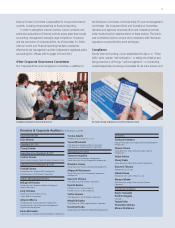Canon 2009 Annual Report Download - page 19
Download and view the complete annual report
Please find page 19 of the 2009 Canon annual report below. You can navigate through the pages in the report by either clicking on the pages listed below, or by using the keyword search tool below to find specific information within the annual report.
17
Through IT reforms, including the Group-wide standardization of 3D-CAD systems, Canon is working to realize sophisticated SCM, thereby bolstering its corporate
structure to agilely respond to changes in management conditions.
product development. And, fi nally, in 2010 Canon expects to com-
plete and launch a Group-wide system based on 3D-CAD systems for
centralizing design information management and supporting the
entire process from development to procurement and production.
In conjunction with 3D-CAD system standardization and integra-
tion, Canon plans to introduce an integrated product data manage-
ment (PDM) system in 2010. This will enable the centralized manage-
ment of technical information accumulated throughout the entire
process, from design to procurement, prototyping and production.
After the unifi cation of 3D-CAD systems and the PDM system
introduction, the Company will possess a platform for “prototype-
less” product development, which will consequently enable the
Company to make development times shorter.
The main advantage offered by IT reforms lies in the resulting
ability to make simultaneous progress across all business processes.
Fully implemented, this unrivalled system may, for example, enable
the scheduled completion of product design to coincide with that of
mold and production equipment design.
From Production to Sales and Marketing
By February 2010, Canon completed the introduction of a new
production system, which initially had been launched by Oita Canon
Inc., at 25 production facilities. This system will not only standardize
our production management systems, it will allow us to link produc-
tion management with the information gathered by our design
divisions as well as the sales information collected by our marketing
front lines.
More recently, Oita Canon introduced a purchase order-oriented
production system. This lean system involves production based on
the information provided by sales companies and confi rmed by
Canon’s production divisions. To enable the optimized management
of inventories, the Company has to develop a supply chain system
that makes full use of information provided by sales companies and
implement this system on a Group-wide scale. If these sales compa-
nies place purchase orders closely linked with real demand in the
market and we manufacture our products strictly based on those
purchase orders, our production and sales will be completely syn-
chronized, which will, in turn, eliminate excessive inventories. Canon
plans to introduce this system at all its plants within the Group.
Also, Canon is accelerating the establishment of a next-generation
logistics system. This logistics system will synchronize production and
shipments based on the Company’s marketing strategies. More
specifi cally, Canon will be able to ship out its products directly from its
plants to sales companies based on their purchase orders and, as a
CanonAR_0325_再校戻し_ipc.indd 17 10.3.26 2:42:06 PM
























